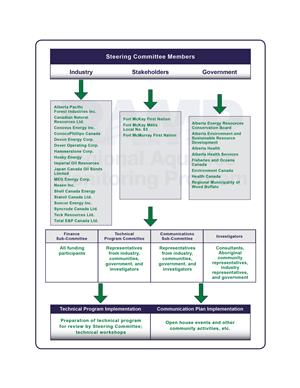RAMP Organization
RAMP is governed by a multi-stakeholder, decision-making body known as the Steering Committee. Functions of the Steering Committee are to:
- prioritize projects within the program objectives to maximize use of available resources;
- review program progress against budget and schedule;
- review program results for relevance to program objectives;
- communicate results and solicit input from interested parties; and
- facilitate communication and linkage with other regional environmental initiatives.
RAMP also has a Technical Program Committee responsible for the development and review of the RAMP technical monitoring program from year to year. The Technical Program Committee is divided into discipline-specific sub-groups that are responsible for for identifying and recommending monitoring activities specific to their discipline for integration into the overall monitoring program. Investigators (i.e. a consultant team, government agencies, industry, Aboriginal members, etc.) primarily carry out the fieldwork, data analysis and reporting, as defined by the program.
A Finance Subcommittee focuses on issues related to the budget and funding for the annual monitoring program. All budget-related information is then submitted to the Steering Committee for final approval. Finally, RAMP has a Communications Coordinator who assists members of the Steering Committee in the transferral of information and monitoring results to local stakeholders and the scientific community. When appropriate, RAMP also participates in communications activities in collaboration with WBEA and CEMA.









